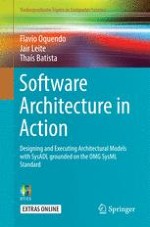This book presents a systematic model-based approach for software architecture according to three complementary viewpoints: structure, behavior, and execution. It covers a unified modeling approach and consolidates theory and practice with well-established learning outcomes.
The authors cover the fundamentals of software architecture description and presents SysADL, a specialization of the OMG Standard Systems Modeling Language (SysML) with the aim of bringing together the expressive power of an Architecture Description Language (ADL) with a standard notation, widely accepted by industry and compliant with the ISO/IEC/IEEE 42010 Standard on Architecture Description in Systems and Software Engineering.
The book is clearly structured in four parts:
The first part focuses on the fundamentals of software architecture, exploring the concepts and constructs for modeling software architecture from differing viewpoints. Each chapter covers a specific viewpoint illustrated with examples of a real system. The second part focuses on how to design software architecture for achieving quality attributes. Each chapter covers a specific quality attribute and presents well-defined approaches to achieve it. Each architectural case study is illustrated with different examples drawn from a real-life system.The third part shows readers how to apply software architecture style to design architectures that meet the quality attributes. Each chapter covers a specific architectural style and gives insights on how to describe substyles. Each style is illustrated by variants and examples of a real-life system.The fourth part presents how to textually represent software architecture models to complement visual notation, including different examples.
Software Architecture in Action is designed for teaching the required modeling techniques to both undergraduate and graduate students, giving them the practical techniques and tools needed to design the architecture of software-intensive systems. Similarly, this book will appeal to software development architects, designers, programmers and project managers too.
